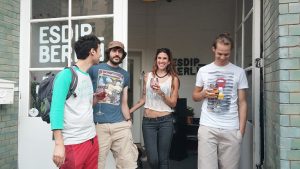Maria Lujan, was working as a freelance graphic designer on the lookout for a new place to work, as she was feeling too isolated at home. After trying out some cafés, she discovered coworking, but couldn’t quite find the space that fit her needs. So she decided to start her own, and that’s how ESDIP Berlin was born.
A hub for, artists, illustrators, cartoonists, designers, programmers, photographers, writers and creative people of all shapes and sizes, ESDIP aims to “encourage and inspire active creators”. In addition to the coworking staples, ESDIP also hosts creative courses and workshops focusing on drawing, graphic design, collage, digital painting, etc, all of which are open to the public.
Today, ESDIP Berlin is one of the most celebrated coworking spaces for artists and creative types.
Hi, Maria. Coworking has proven to successfully bring freelancers and entrepreneurs together, but how can coworking accommodate artists?
They key is to find the right coworking space for your needs, with the right atmosphere and people with similar interests. Of course, you need to do a bit of searching and compare each space.
Since our members at ESDIP are mostly creatives, such as designers, animators, illustrators, etc, it’s important for them to have exposure to other artists. It is very common to see them working together on new projects and also helping each other by sharing projects.
What are some of the programs you offer to help your members find work and funding?
We encourage our members to stay creative and support them as well as their projects.
In order to do this, we host artistic workshops almost every evening for coworkers, but these events are also open to the public. In addition, we also hold creative meetings regularly, and coworkers can participate in all of our creative events, by showing their art at our gallery or giving talks.
How is coworking different for those working in the creative industries?
It takes a lot of events, workshops and collaboration. For instance, we constantly host workshops and courses to encourage and motivate our coworkers to stay creative by finding ways to enhance their knowledge and improve their skills. We try to make our classes affordable and accessible.
What types of events do you offer outside of the coworking space?
We organize creative events and informal get-togethers for our coworkers and the public, which aim to help them network, get motivated and learn from one another. For example, we offer life-drawing classes, which gives artists in Berlin the chance to meet, and draw together. As we also have the support of ESDIP Madrid, teachers from our school in Madrid often travel to Berlin to give the classes.

Community at ESDIP Berlin
And, once a year we host “ESDIP Berlin Connect” an event where creatives from different fields are meeting together to network, share job openings, opinions, etc., in the hopes of providing encouragement, motivation, and inspiration to others. We make a selection of five coworkers to talk about their work and present their projects.
If you were to give advice to someone looking to create a similar platform to ESDIP what would you suggest for them to do?
Our creative community is what differentiates our space from others. Identifying our market and loving is what brings us success. If a coworking space loses sight of the target market and becomes too broad in its offerings, it might lose its identity and become just another shared office.
Of course, there can be people from different backgrounds working in the same space and this could be a benefit for coworkers since they complement each other.Yet, it’s knowing your community well that is essential to keep users coming back. You can only be completely connected with them if you are part of the creative field as well.
How coworking allowed you to make partnerships with other creative networks that you might not otherwise have access to?
Our last exhibition was a collaboration with the collective Urban Art Clash, where screen printing posters and a lot of art pieces from the most popular Berlin-based street artists were shown. Together with exhibitions, we offered free workshops, live painting shows in addition to screen printing demonstrations.
How does coworking connect you to external creative resources that you couldn’t access from more traditional studios?
Overall, coworking spaces give you a sense of community and help you network. Many places organize outings and events or have a coffee shop or a nice kitchen that help coworkers to engage with others, even if it’s only small talk between tasks. These spaces provide many opportunities for collaboration with other creative professionals you might not have met otherwise.
You also have a location in Madrid. How is that location different?
ESDIP Madrid is an art institution founded in 1983. They offer professional courses in the fields of animation, illustration and design. They also organize art exhibitions and events for their students and for the public.
Some of the courses we offer here in Berlin are part of the ESDIP Madrid program and the same teachers travel to Berlin to give the classes. Students from ESDIP Madrid also come to Berlin to join our courses.
Does having two locations enhance your artistic network, and if so, how?
It’s really wonderful to have access to two locations, both of which are in such inspiring cities like Madrid and Berlin. It opens up so many doors to new opportunities that could not exist in a single space.
Keeping both spaces connected provides more opportunities for collaboration with other talented creative people. We put our members with professionals from Spain who are willing to work on new projects, thus enhancing cross-collaboration
In addition to project sharing, coworkers are often able to travel with their work, so having a second location that feels “like home” is priceless.



0 Comments